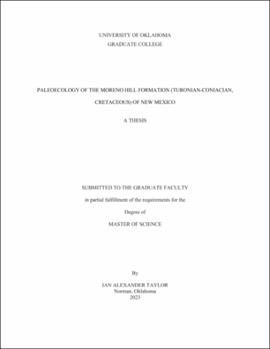| dc.contributor.advisor | Lupia, Richard | |
| dc.contributor.author | Taylor, Ian | |
| dc.date.accessioned | 2023-07-28T15:33:54Z | |
| dc.date.available | 2023-07-28T15:33:54Z | |
| dc.date.issued | 2023 | |
| dc.identifier.uri | https://hdl.handle.net/11244/338736 | |
| dc.description.abstract | The Cretaceous Terrestrial Revolution was a period of diversification of all major terrestrial groups that coincides with the rapid evolution and establishment of angiosperms (flowering plants) that began ~125 million years ago. The Moreno Hill Formation (MHF) was deposited over a two-million-year span of time during the late Early Cretaceous (90.9 Ma-88.6 Ma) and is a near-shore terrestrial deposit, except for a marine incursion near the base of the formation. The Moreno Hill Formation coincides with the first peak of angiosperm diversity in the Cretaceous. A moderately diverse vertebrate fauna has been recovered from the MHF including several members of Dinosauria. To better understand the ecology and climate of the formation, I analyzed four fossil wood specimens—three from the lower member and one from the upper member—to determine the taxonomic relationships of those woods, and the climate during deposition of the Moreno Hill Formation. On the basis of character analysis, all four specimens are assigned to Cupressinoxylon sp. aff. C. manuelli. The growth habits of the woods from the lower member and the wood from the upper member were found to be different suggesting a change in climate from the lower member to the upper member. I also developed a new method for the analysis of palynodebris (acid-resistant organic remains) using samples that were collected from the upper member of the Moreno Hill Formation. I utilized the Malvern Morphologi G3 morphometric microscope and its associated software. My new protocol to automate collection of palynodebris data was compared to data collected by conventional analysis in order to evaluate the method’s efficacy. I then used both data sets to interpret changes in taphonomic signatures that could affect interpretation of paleoecological data from the Moreno Hill Formation. | en_US |
| dc.language | en_US | en_US |
| dc.subject | Paleoecology | en_US |
| dc.subject | Moreno Hill Formation | en_US |
| dc.subject | Palynodebris | en_US |
| dc.title | Paleoecology of the Moreno Hill Formation (Turonian-Coniacian, Cretaceous) of New Mexico | en_US |
| dc.contributor.committeeMember | Dulin, Shannon | |
| dc.contributor.committeeMember | Lungmus, Jacqueline | |
| dc.date.manuscript | 2023-07-21 | |
| dc.thesis.degree | Master of Science | en_US |
| ou.group | Mewbourne College of Earth and Energy::School of Geosciences | en_US |
